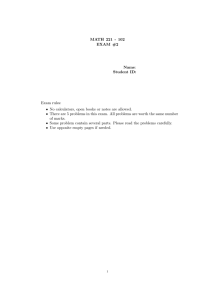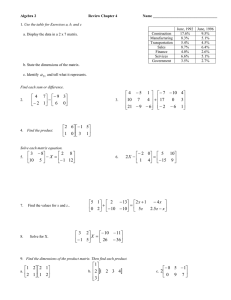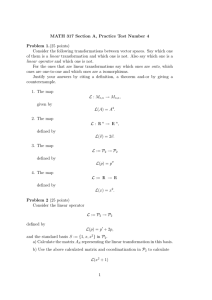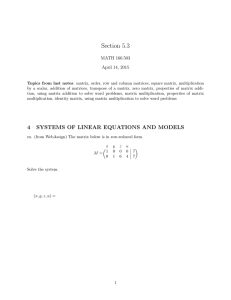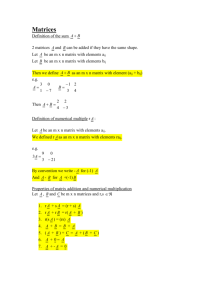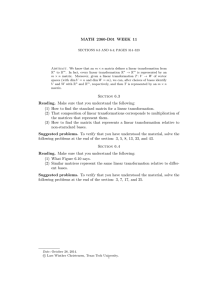MATH 223: Linear Transformations and 2 × 2 matrices. a b A
advertisement
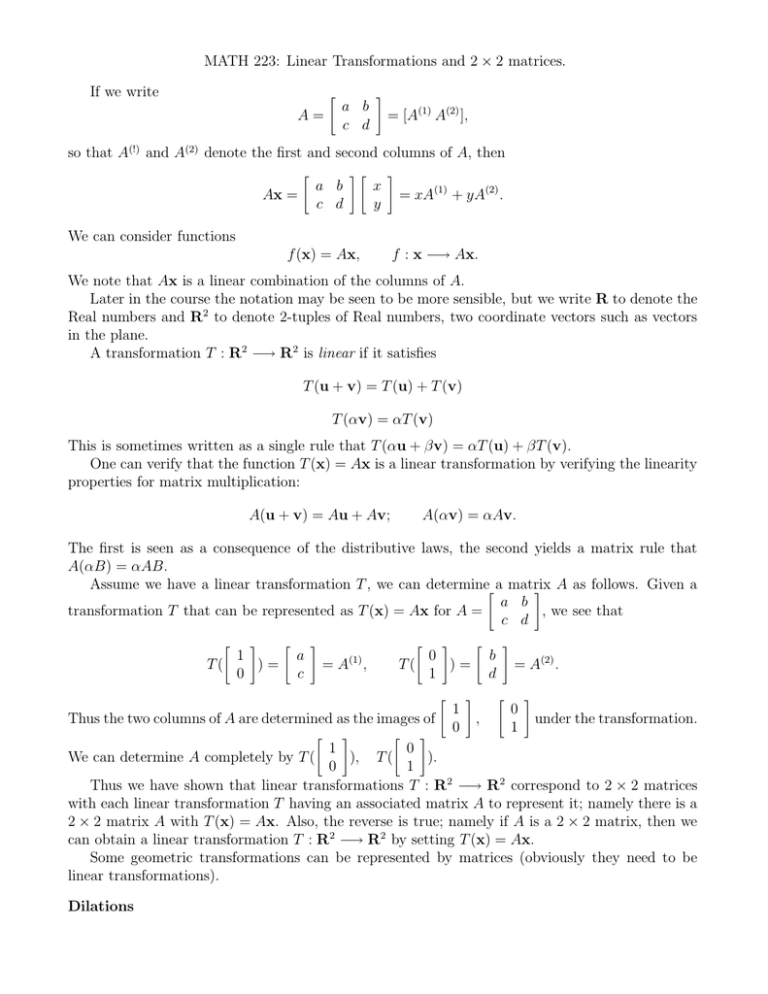
MATH 223: Linear Transformations and 2 × 2 matrices. If we write A= " a b c d # = [A(1) A(2) ], so that A(!) and A(2) denote the first and second columns of A, then Ax = " #" a b c d x y # = xA(1) + yA(2) . We can consider functions f (x) = Ax, f : x −→ Ax. We note that Ax is a linear combination of the columns of A. Later in the course the notation may be seen to be more sensible, but we write R to denote the Real numbers and R2 to denote 2-tuples of Real numbers, two coordinate vectors such as vectors in the plane. A transformation T : R2 −→ R2 is linear if it satisfies T (u + v) = T (u) + T (v) T (αv) = αT (v) This is sometimes written as a single rule that T (αu + βv) = αT (u) + βT (v). One can verify that the function T (x) = Ax is a linear transformation by verifying the linearity properties for matrix multiplication: A(u + v) = Au + Av; A(αv) = αAv. The first is seen as a consequence of the distributive laws, the second yields a matrix rule that A(αB) = αAB. Assume we have a linear transformation T , we can determine" a matrix # A as follows. Given a a b , we see that transformation T that can be represented as T (x) = Ax for A = c d " # 1 )= T( 0 " a c # (1) =A , " Thus the two columns of A are determined as the images of " # # 0 T( )= 1 " # " 1 0 # " , b d # " = A(2) . 0 1 # under the transformation. 1 0 ), T ( ). 0 1 Thus we have shown that linear transformations T : R2 −→ R2 correspond to 2 × 2 matrices with each linear transformation T having an associated matrix A to represent it; namely there is a 2 × 2 matrix A with T (x) = Ax. Also, the reverse is true; namely if A is a 2 × 2 matrix, then we can obtain a linear transformation T : R2 −→ R2 by setting T (x) = Ax. Some geometric transformations can be represented by matrices (obviously they need to be linear transformations). We can determine A completely by T ( Dilations These are the transformations stretching by various factors in different directions. Let D(d1 , d2 ) = " # d1 0 0 d2 . then the transformation T (x) = D(d1 , d2 )x stretches by a factor d1 in the x direction and a factor d2 in the y direction. Rotations These are the most beautiful 2 × 2 examples. Let R(θ) be the matrix corresponding to rotation by θ in the counterclockwise direction. We note that " # " 1 R(θ)( )= 0 # cos θ sin θ " # 0 R(θ)( )= 1 , " − sin θ cos θ # This yields the matrix which represents the transformation (assuming rotation is linear; which you can show) " # cos θ − sin θ R(θ) = . sin θ cos θ Shears These transformations seem a little more unusual and are less commonly mentioned. Let G12 (γ) = " 1 γ 0 1 # . This is seen to be the shear by a factor γ in the x direction. The following wonderful thing happens as a consequence of our associating functions with matrices. Function composition becomes matrix multiplication. Let T1 (x) = A1 x and T2 (x) = A2 x where A1 = " a b c d # A2 = , " e f g h # # " e g # " ae ce # af cf # . Then we consider the composition T1 ◦ T2 . We have # " 1 T1 ( )= 0 " a c # , " # 0 T( )= 1 " b d # , " 1 T2 ( )= 0 " # , 0 T( )= 1 + " bg dg " bh dh # " f h # . Now " # " # " # " # " # " # " 1 e 1 0 T1 ◦ T 2 ( ) = T1 ( ) = eT1 ( ) + gT1 ( )= 0 g 0 1 # = " ae + bg ce + dg # af + bh cf + dh # and similarily " # " # 0 f 1 0 T1 ◦ T 2 ( ) = T1 ( ) = f T1 ( ) + hT1 ( ) 1 h 0 1 Putting this together, we obtain that the matrix for T1 ◦ T2 is " ae + bg af + bh ce + dg cf + dh # + == " . which is the matrix product A1 A2 . Thus function composition corresponds to matrix multiplication. You can imagine that the rules for matrix multiplication came from a desire to have this hold. A beautiful consequence of this is the associativity of matrix multiplication which follows from the associativity of function composition T1 ◦ (T2 ◦ T3 ) = (T1 ◦ T2 ) ◦ T3 (which follows from computing that (T1 ◦ (T2 ◦ T3 ))(x) = T1 (T2 (T3 (x))) = ((T1 ◦ T2 ) ◦ T3 )(x)) and so A1 (A2 A3 ) = (A1 A2 )A3 . Please note the order of the operations. The transformation T1 ◦ T2 ◦ T3 acts as first T3 , then T2 , then T1 . Since the order of matrix multiplication is important, you must check this carefully in problems. In this vein, we see that a matrix inverse is related to the compositional inverse of linear functions. The uniqueness of the matrix inverse is easily understood (and proved) in the function context. Similarly the fact that the inverse matrix commutes with the original matrix namely AA−1 = A−1 A follows directly from the compositional inverse.
